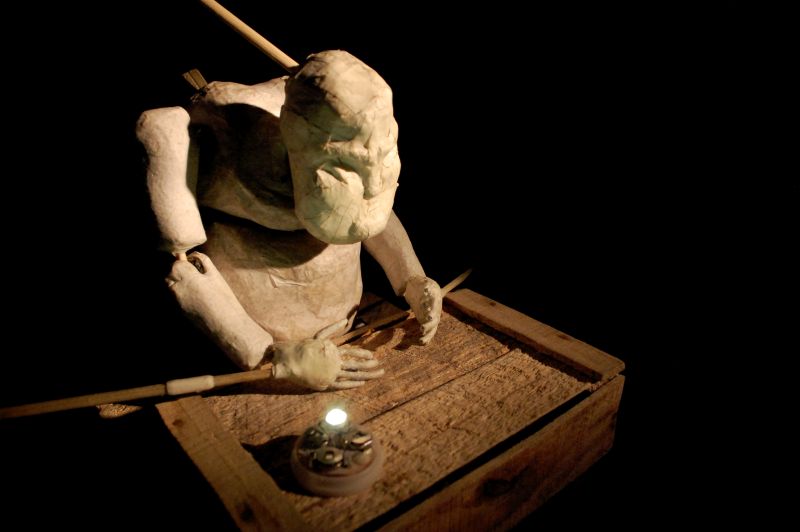 It begins with a death. The small, fragile-looking, pale figure is working underground, in a tunnel supported by wonky struts and lit by tiny lamps. He hammers, he shovels. There are drips and echoes, sounds of other work going on unseen around him, and then there is a louder sound. He is alarmed. One of his puppeteers stands, and pours a basketful of debris from above. He tries to run, but there is no escape. He falls, and is crushed. He struggles and then he is still. Silently, gently, his puppeteers withdraw their control rods from his white-paper body.
It begins with a death. The small, fragile-looking, pale figure is working underground, in a tunnel supported by wonky struts and lit by tiny lamps. He hammers, he shovels. There are drips and echoes, sounds of other work going on unseen around him, and then there is a louder sound. He is alarmed. One of his puppeteers stands, and pours a basketful of debris from above. He tries to run, but there is no escape. He falls, and is crushed. He struggles and then he is still. Silently, gently, his puppeteers withdraw their control rods from his white-paper body.
Puppets do death very well.
Chiflón: The Silence of the Coal is framed by underground deaths, between which we also see into the above-ground lives of the miners and their families. The show, brought to the Brighton Festival by Chilean puppetry company Silencio Blanco, is based on the story of a 19th-century miner, but intentionally pulls on memories of more recent disasters.
It is entirely performed by small paper-based white figurative rod puppets, operated tabletop/bunraku style by a team of black-clad hooded puppeteers. There is no text, indeed in the publicity the show is repeatedly described as ‘silent’ – but (leaving for the moment the constant soundtrack) the puppets do, in fact, speak: we see their conversations, their attitudes and gestures of speech, both delivered and heard. This is no less real speech than their actions are real actions. The main mode of performance, in fact, is a kind of puppet naturalism: all movement is very human-like – nothing here of the wild or transformative or scale-changing possibilities of the form. When it works, this method is effective – it’s like magical translation, and we understand their conversations. If ever you lose the thread, though (as I did in one section with the miner’s wife and – I’m guessing – their daughter) you are properly lost, and easily disengaged: there isn’t a strong metaphorical or visual language to read; you’re just watching a conversation, an interaction, that you don’t understand.
The puppeteers, although dressed in blacks and hoods, are not ‘invisible’ entirely: they interact functionally with the puppets, fetching objects, turning lights on and off in their world, and, touchingly, withdraw their operating rods at the points of death; there’s a hint of their presence as fates, as anima, but this is never explicit or overplayed.
The soundtrack is mostly built of simple sounds (birds, water, footsteps) and functions to situate us – it shifts between interior, exterior, and underground, and between night and day. There are just a couple of moments where extradiegetic melodic sound intrudes – at the ending, and the other is the piece’s singular moment of fantastical imagery, when the women’s laundry expands to fill the stage. It’s a relief, this scene, although only a small stretch from the other stage-pictures and languages: it is a breath of something bigger than the very constricted world of the miners.
And this constriction and limitation feels honest but is dramatically a bit suffocating. The puppeteers are exceptionally skilled and work seamlessly together to keep the figures alive, to give every flicker and gesture accurately, but it feels as though they’re working from an overly-restricted palette, and sometimes at great length. Through a commitment to truthfulness the show becomes too austere to connect fully with the audience. It also struggles to reach across the relatively large and wide space of the Dome Studio – I was about halfway back, but at the end of a row; I struggled to keep focus and follow the detail of the puppets – I felt I was about as far away from them as I could have managed. Being at the side meant I missed several moments, and the downstage-centre finale was obscured almost entirely by set, puppeteers and audience.
Although it is great to see an international puppetry company featured in the Brighton Festival, and always intriguing for puppet fans to see work of this level, this was possibly not the best introduction to theatrical puppetry for a general audience.

